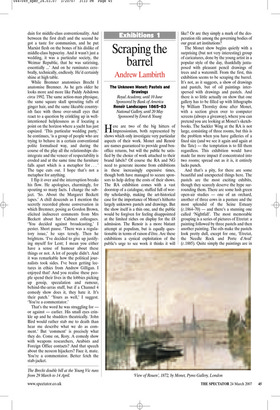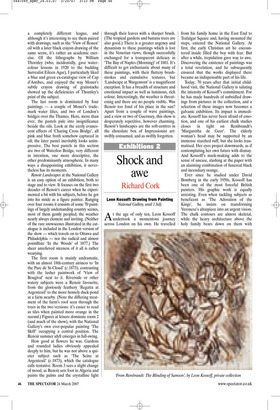Scraping the barrel
Andrew Lambirth
The Unknown Monet: Pastels and Drawings Royal Academy, until 10 June Sponsored by Bank of America Renoir Landscapes 1865–83 National Gallery, until 20 May Sponsored by Ernst & Young
Here are two of the big hitters of Impressionism, both represented by shows which only investigate very particular aspects of their work. Monet and Renoir are names guaranteed to provide good boxoffice returns, but will the public be satisfied by the choice of work attached to their brand labels? Of course the RA and NG need to generate income from exhibitions in these increasingly expensive times, though both have managed to secure sponsors to help defray the costs of their shows. The RA exhibition comes with a vast doorstop of a catalogue, stuffed full of worthy scholarship, making the art-historical case for the importance of Monet’s hitherto largely unknown pastels and drawings. But the show itself is a thin one, and the public would be forgiven for feeling disappointed at the limited riches on display for the £8 admission. The Renoir is a more blatant attempt at populism, but is equally questionable in terms of raison d’être. Are these exhibitions a cynical exploitation of the public’s urge to see work it thinks it will like? Or are they simply a mark of the desperation rife among the governing bodies of our great art institutions?
The Monet show begins quietly with a surprising (but not very interesting) group of caricatures, done by the young artist in a popular style of the day, thankfully juxtaposed with pleasant pencil drawings of trees and a watermill. From the first, this exhibition seems to be scraping the barrel. It’s not, as it suggests, a show of drawings and pastels, but of oil paintings interspersed with drawings and pastels. And there is so little actually on show that one gallery has to be filled up with lithographs by William Thornley done after Monet, with a section given over to computer screens (always a giveaway), where you can pretend you are looking at Monet’s sketchbooks. The Sackler Wing at the RA is not large, consisting of three rooms, but this is the problem when you have galleries of a fixed size (and we see it again and again at the Tate) — the temptation is to fill them regardless. This exhibition would have made far more impact if concentrated into two rooms; spread out as it is, it entirely lacks punch.
And that’s a pity, for there are some beautiful and unexpected things here. The pastels are the most exciting exhibits, though they scarcely deserve the hype surrounding them. There are some lush green open-air studies — one of an orchard, another of three cows in a pasture and the most splendid of the Seine Estuary (c.1864–70) — and there’s a stunning one called ‘Nightfall’. The most memorable grouping is a series of pictures of Etretat: a painting followed by three pastels and then another painting. The oils make the pastels look pretty dull, except for one, ‘Etretat, the Needle Rock and Porte d’Aval’ (c.1885). Quite simply the paintings are in a completely different league, and although it’s interesting to see them paired with drawings, such as the ‘View of Rouen’ oil with a later black crayon drawing of the same scene, it’s rather an academic exercise. Of the lithographs by William Thornley (who, incidentally, gave watercolour lessons in 1920 to the budding Surrealist Eileen Agar), I particularly liked a blue and green ex-catalogue view of Cap d’Antibes, and enjoyed the way Monet’s subtle crayon drawing of grainstacks showed up the deficiencies of Thornley’s print of the subject.
The last room is dominated by four paintings — a couple of Monet’s trademark water lilies, and two of London’s bridges over the Thames. Here, more than ever, the pastels pale into insignificance beside the oils. Look at the eerily evanescent effects of ‘Charing Cross Bridge’, all pink and blue froth somehow captured in oil; the later pastel inevitably looks unimpressive. The best pastels in this section are two of Waterloo Bridge, very different in intention, one more descriptive, the other predominantly atmospheric. In many ways a disappointing exhibition, it nevertheless has its moments.
Renoir Landscapes at the National Gallery is an easy option of an exhibition, both to stage and to view. It focuses on the first two decades of Renoir’s career when he experimented a bit with his subjects, before he got into his stride as a figure painter. Ranging over four rooms it consists of some 70 paintings of largely undemanding country scenes, most of them gently peopled, the weather nearly always clement and inviting. (Neither of the rare snowscenes illustrated in the catalogue is included in the London version of the show — which travels on to Ottawa and Philadelphia — nor the radical and almost pointilliste ‘In the Woods’ of 1877.) The sheer unrelieved niceness of it all is rather wearying.
The first room is mainly undramatic, with an almost 18th-century airiness to ‘In the Parc de St-Cloud’ (c.1873), contrasting with the lusher paintwork of ‘View of Bougival’ next to it. Riverside or other watery subjects were a Renoir favourite, from the gloriously feathery ‘Regatta at Argenteuil’ to the more homely duck-pond at a farm nearby. (Note the differing treatment of the farm’s roof seen through the trees in the two versions: it’s easier to read as tiles when painted more orange in the second.) Figures at leisure dominate room 2 (and much of the show), with the National Gallery’s own ever-popular painting ‘The Skiff’ occupying a central position. The Renoir summer idyll emerges in full-swing.
How good at flowers he was. Gardens and rounded ladies obviously appealed deeply to him, but he was not above a quieter subject such as ‘The Seine at Argenteuil’ (c.1873), which the catalogue calls tentative. Room 3 sees a slight change of mood, as Renoir sets foot in Algeria and paints the palms and the crystalline light through their leaves with a sharper brush. (The tropical gardens and banana trees are also good.) There is a greater urgency and dynamism to these paintings which is lost in the Venetian views, though successfully exchanged for a transparent delicacy in ‘The Bay of Naples (Morning)’ of 1881. It’s difficult to get enthusiastic about many of these paintings, with their fluttery brushstrokes and cumulative textures, but ‘Landscape at Wargemont’ is a magnificent exception. It has a breadth of structure and emotional impact as well as luminous, rich colour. Interestingly, the weather is threatening and there are no people visible. Was Renoir too fond of his place in the sun? Apart from a couple of wave paintings, and a view or two of Guernsey, this show is desperately repetitive, however charming. Renoir’s landscapes are the soft-centres in the chocolate box of Impressionist art: swiftly consumed, and as swiftly forgotten.



















































































 Previous page
Previous page